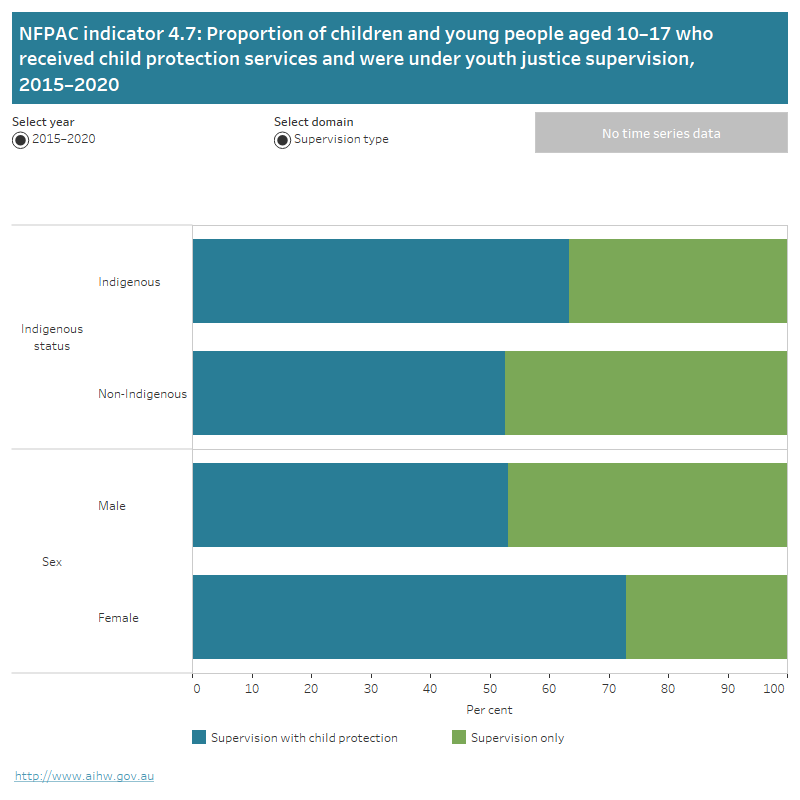4.7 Cross-sector clients
Research shows that children and young people who have been abused or neglected are at greater risk of engaging in criminal activity and entering the youth justice system. Similarly, those who are in the youth justice system, particularly in detention, are highly likely to have had a history of abuse or neglect.
Procedures used within the child protection and youth justice systems can also facilitate involvement of one system with the other. For example, contact with youth justice agencies may lead to a child protection notification being made if abuse or neglect is suspected by, or reported to, agency staff.
The available data for this indicator captures young people under youth justice supervision during 2019–20 who had received child protection services in the 5 years from 1 July 2015 to 30 June 2020.
‘In the child protection system’ includes children who were in at least one component of the system at some time during the reference period (i.e. the subject of an investigated notification and/or on a care and protection order and/or in out-of-home care).
‘Under youth justice supervision’ includes children who were in at least one component of the system at some time during the reference period (i.e. under community-based supervision and/or in detention).
Trend data: For all indicator displays, the yearly trend is limited to indicators with 3 or more years (including the current year) of comparable time series data. To see the trend click on “Yearly Trend” button on the display. Where 3 or more years of comparable data including the most recent year is not available, a “No time series data” message is shown on the display.
The horizontal bar graph shows the proportion of children and young people aged 10–17 who received child protection services and were under youth justice supervision, in 2015–20 by Indigenous status and sex. Each stacked bar presents the proportion of children with supervision and child protection and supervision only.

Source: AIHW (2021) Unpublished. Linked youth justice national minimum data set and child protection national minimum data set collection 2019–20, AIHW, Australian Government.
See the supplementary data tables for further information and footnotes about these data.
Indicator technical specifications
The information below provides technical specifications for the summary indicator data presented in the quick reference guide.
| Definition | Data source | |
|---|---|---|
| Numerator | Children aged 10-17 who were in the child protection system and were under youth justice supervision | AIHW child protection and youth justice supervision linked data collection |
| Denominator | Children age 10-17 who were in the child protection system during the reference period | AIHW child protection and youth justice supervision linked data collection |
Explanatory notes
The available data for this indicator capture child protection clients who entered youth justice services (but not those who sought assistance from homelessness services).
The available data are restricted to children aged 10–17. Because children under the age of 10 cannot be under youth supervision, it is not possible for children in this age group who are in the child protection system to also be under youth justice supervision. For this reason, children who are aged under 10 and in the child protection system are excluded.
The scope of youth justice data in the linked dataset is restricted to investigated notifications, care and protection orders and out-of-home care. Notifications that were not investigated, care and protection orders that were ‘other’ or ‘not stated’ and living arrangements that do not constitute out-of-home care are excluded.
The scope of youth justice data in the linked dataset is restricted to supervised community-based orders and detention orders (both unsentenced and sentenced). Unsupervised orders such as unsupervised bail, or diversionary activities that are not supervised orders are excluded.
‘In the child protection system’ includes children who were in at least one component of the system at some time during the reference period (i.e. the subject of an investigated notification and/or on a care and protection order and/or in out-of-home care).
‘Under youth justice supervision’ includes children who were in at least one component of the system at some time during the reference period (i.e. under community-based supervision and/or in detention).


